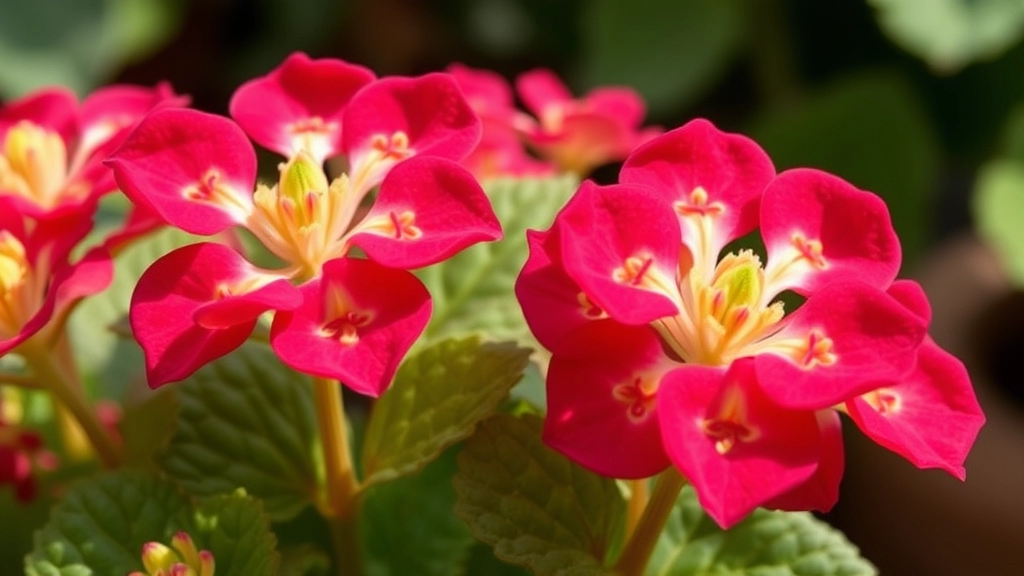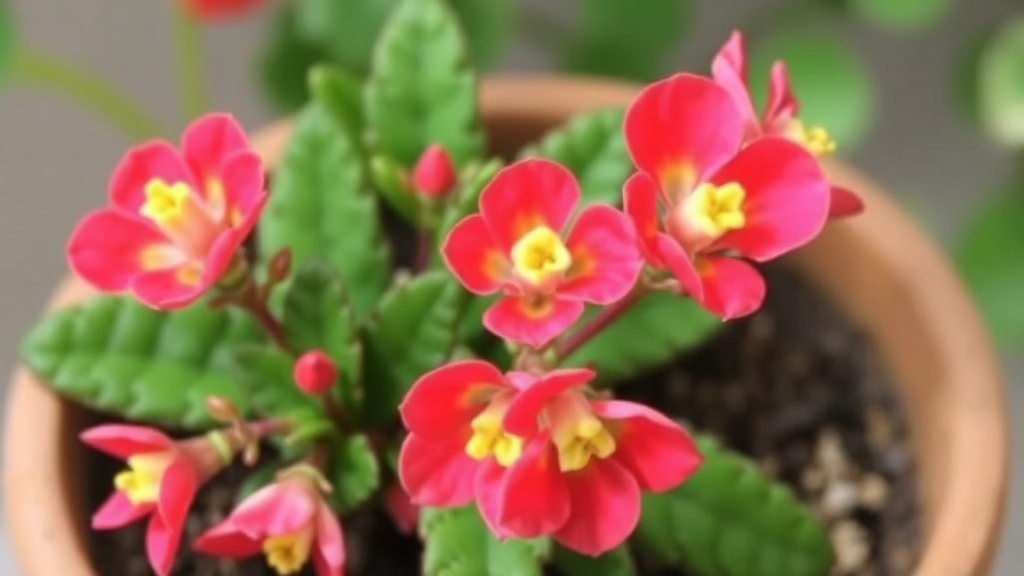Kalanchoe Plant and Cat Safety
As a cat owner, I know how important it is to keep our furry friends safe from harmful plants. One plant that often raises concerns is the Kalanchoe plant. You might have heard that the Kalanchoe plant is toxic to cats, and it’s true. This popular succulent can cause serious health issues for our feline companions if ingested.
Understanding the Risks
Understanding the risks associated with the Kalanchoe plant is crucial for any pet owner. Symptoms of toxicity in cats include:
- Vomiting
- Diarrhea
- Abnormal heart rhythms
It’s essential to keep this plant out of reach and be aware of the signs of poisoning to ensure your cat stays healthy and happy.
Identifying Kalanchoe Plants
Are you unsure whether the plant in your home is a Kalanchoe?
Identifying Kalanchoe plants is crucial, especially for cat owners, as these beautiful succulents can pose serious health risks to our feline friends.
Kalanchoe is a genus of succulent plants that are popular for their vibrant flowers and easy care. Here are some key characteristics to help you identify them:
- Leaves: Kalanchoe plants typically have thick, fleshy leaves that can vary in shape from rounded to serrated. The leaves are often green but can also have a reddish hue or variegated patterns.
- Flowers: They produce clusters of small, tubular flowers that can be pink, red, yellow, or white, depending on the species. Flowering usually occurs in the spring and summer.
- Growth Habit: Kalanchoe plants can grow upright or trail, depending on the variety. They are generally compact and can reach heights of 30-90 cm.
- Common Varieties: The most common types include Kalanchoe blossfeldiana (flaming Katy), Kalanchoe tomentosa (panda plant), and Kalanchoe daigremontiana (mother of thousands).
Being able to identify Kalanchoe plants is essential for ensuring the safety of your pets.
Toxic Components in Kalanchoe

So, you’ve got a Kalanchoe plant in your home, and you’re wondering if it’s safe for your furry friend.
Here’s the scoop: Kalanchoe contains toxic compounds that can be harmful to cats.
Key Toxic Components
- Cardiac Glycosides: These are the main culprits. They can mess with your cat’s heart rhythm and lead to serious health issues.
- Bufadienolides: Another group of toxins found in Kalanchoe, which can also affect the heart and cause gastrointestinal distress.
Why Should You Care?
Even small amounts of Kalanchoe can lead to poisoning.
If your cat nibbles on a leaf or two, it’s not just a harmless snack.
Quick Facts
- All Parts Are Toxic: Leaves, flowers, and stems all contain these harmful components.
- Severity Varies: The toxicity can vary depending on the specific type of Kalanchoe, but it’s best to treat them all as potentially dangerous.
Symptoms of Kalanchoe Poisoning in Cats
If you suspect your cat has ingested Kalanchoe, it’s crucial to be aware of the symptoms that may arise. Recognising these signs early can make a significant difference in your cat’s health.
Common Symptoms of Kalanchoe Poisoning:
- Gastrointestinal Distress
- Vomiting
- Diarrhoea
- Abdominal pain
- Neurological Signs
- Lethargy
- Weakness
- Tremors or seizures
- Cardiac Issues
- Rapid heart rate
- Arrhythmias
- Respiratory Distress
- Difficulty breathing
- Coughing
It’s important to note that these symptoms may not appear immediately. They can develop within a few hours to a couple of days after ingestion.
For instance, a friend of mine once noticed her cat seemed unusually tired and was vomiting after she brought home a Kalanchoe plant. It was a worrying situation that led her to the vet quickly, where they confirmed it was indeed Kalanchoe poisoning.
To prevent such incidents, it’s essential to be aware of the toxicity risks and safety tips associated with Kalanchoe plants.
First Aid and Immediate Actions

When you discover that your cat has ingested Kalanchoe, panic can set in. What should you do next?
First and foremost, stay calm. Your cat’s safety is paramount, and knowing the right steps can make all the difference.
Immediate Steps to Take
- Remove Access: Quickly remove any remaining Kalanchoe plants from your cat’s vicinity to prevent further ingestion.
- Assess the Situation: Try to determine how much of the plant your cat has eaten. Note any symptoms you observe, such as vomiting or lethargy.
- Contact Your Vet: Call your veterinarian or an emergency animal clinic immediately. Provide them with details about your cat’s condition and the amount of Kalanchoe consumed.
- Do Not Induce Vomiting: Unless instructed by a veterinarian, avoid inducing vomiting. This can sometimes do more harm than good.
- Monitor Symptoms: Keep a close eye on your cat for any changes in behaviour or health. Document any symptoms to share with your vet.
- Keep Calm: Your cat can sense your stress. Remaining calm helps to keep your cat at ease during this stressful time.
Preparing for the Vet Visit
When you visit the vet, it’s helpful to have the following information ready:
- Plant Identification: Confirm that it is indeed Kalanchoe.
- Time of Ingestion: Note when the incident occurred.
- Symptoms Observed: List any symptoms your cat has displayed.
These details can assist your veterinarian in providing the best care possible.
When faced with Kalanchoe poisoning in cats, immediate veterinary intervention is crucial. You may wonder what steps to take and what treatments are available to ensure your feline friend receives the best care possible.
Upon arrival at the veterinary clinic, the veterinarian will conduct a thorough examination. They will assess:
– **Vital Signs**: Monitoring heart rate, respiratory rate, and temperature.
– **Neurological Evaluation**: Checking for any signs of distress or abnormal behaviour.
– **Digestive Health**: Evaluating symptoms like vomiting or diarrhea.
Depending on the severity of the poisoning, several treatment options may be employed:
– **Inducing Vomiting**: If ingestion was recent, the vet may induce vomiting to prevent further absorption of toxins.
– **Activated Charcoal**: Administering activated charcoal can help bind the toxins in the gastrointestinal tract.
– **Intravenous Fluids**: To prevent dehydration and support kidney function, IV fluids may be necessary.
– **Medications**: Anti-nausea and anti-seizure medications might be prescribed to manage symptoms effectively.
Post-treatment, your cat will require monitoring to ensure they recover fully. This may involve:
– **Follow-Up Visits**: Regular check-ups to assess recovery and any lingering effects.
– **Home Care Instructions**: Your vet will provide guidelines on how to care for your cat at home, including dietary recommendations and activity restrictions.
It’s essential to provide emotional support to your cat during recovery. Your presence can help alleviate stress and anxiety, which can be just as important as medical treatment.
For more information on the symptoms and prevention of Kalanchoe poisoning in cats, you can refer to [this guide](https://planthq.org/is-florist-kalanchoe-toxic-to-cats-symptoms-prevention/). Additionally, if you’re interested in propagating Kalanchoe plants, check out this [step-by-step guide](https://planthq.org/how-to-propagate-leggy-kalanchoe-stepbystep-guide/).
Preventing Kalanchoe Exposure

So, you’ve learned about the dangers of Kalanchoe for our feline friends. Now, let’s dive into how to keep your curious kitty safe from this toxic plant.
Why Prevention Matters
Cats are naturally inquisitive. They love to explore, sniff, and nibble on plants. Knowing how to prevent Kalanchoe exposure is crucial for any cat owner.
Tips for Keeping Kitties Safe:
- Choose Cat-Friendly Plants: When selecting houseplants, look for non-toxic options. Popular choices include spider plants, Boston ferns, and cat grass.
- Plant Placement: Keep Kalanchoe and other toxic plants out of reach. High shelves or closed rooms can be effective.
- Educate Yourself: Familiarise yourself with common toxic plants. This knowledge can help you make informed choices when adding greenery to your home.
- Use Deterrents: If your cat is a persistent plant nibbler, consider using pet-safe deterrent sprays or placing citrus peels near plants, as most cats dislike the smell.
- Regular Check-Ins: If you have guests, remind them not to bring Kalanchoe or similar plants into your home.
- Monitor Your Cat: Keep an eye on your kitty’s behaviour. If they seem overly interested in a plant, intervene before they get too close.
By taking these steps, you can create a safer environment for your furry companion.
Safe Plant Alternatives for Cat Owners
As we explore safe options for cat owners, it’s essential to consider plants that are both non-toxic and visually appealing. Many pet owners worry about the potential dangers of common houseplants, like Kalanchoe, which can be harmful to our feline friends.
Safe Plant Options
Here are some excellent alternatives to Kalanchoe that will keep your home vibrant without risking your cat’s health:
- Spider Plant (Chlorophytum comosum)
A hardy plant that thrives in various conditions and is safe for cats. Its arching leaves add a touch of elegance to any room. - Boston Fern (Nephrolepis exaltata)
This lush fern not only purifies the air but is also non-toxic to cats. It prefers humidity, making it perfect for bathrooms or kitchens. - Areca Palm (Dypsis lutescens)
A popular indoor palm that can grow tall and adds a tropical feel to your space. It’s safe for pets and easy to care for. - Bamboo Palm (Chamaedorea seifrizii)
Another palm option that is non-toxic and effective at removing indoor pollutants. It’s a great choice for pet-friendly homes. - Calathea (Calathea spp.)
Known for its stunning foliage, Calathea is safe for cats and thrives in indirect light, making it a beautiful addition to any room.
Tips for Choosing Safe Plants
When selecting plants for your home, consider the following:
- Research: Always check if a plant is safe for pets before bringing it home.
- Placement: Keep plants out of reach if your cat is particularly curious.
- Variety: Choose a mix of plants to create a vibrant indoor garden while ensuring they are all non-toxic.
By opting for these safe plant alternatives, you can enjoy the beauty of greenery in your home without worrying about your cat’s safety. If you are still interested in Kalanchoe, make sure to read about how Kalanchoe can grow indoors and the causes and solutions for Kalanchoe leaves curling to ensure you are fully informed.
FAQs About Kalanchoe Plant Toxicity to Cats
Is the Kalanchoe plant toxic to cats?
Yes, the Kalanchoe plant contains toxic compounds that can be harmful to cats. Even small amounts can lead to poisoning.
What are the toxic components in Kalanchoe?
The primary toxic components in Kalanchoe are Cardiac Glycosides and Bufadienolides. These can affect your cat’s heart rhythm and cause gastrointestinal distress.
Which parts of the Kalanchoe plant are toxic?
All parts of the Kalanchoe plant are toxic, including the leaves, flowers, and stems.
What symptoms should I look for if my cat has ingested Kalanchoe?
Common symptoms include vomiting, lethargy, and changes in heart rhythm. If you notice any of these signs, contact your veterinarian immediately.
What should I do if my cat eats Kalanchoe?
First, stay calm. Remove any remaining Kalanchoe plants from your cat’s reach, assess how much was ingested, and contact your veterinarian right away. Do not induce vomiting unless instructed by a vet.
How can I prevent my cat from accessing toxic plants like Kalanchoe?
To prevent exposure, choose cat-friendly plants, place toxic plants out of reach, use pet-safe deterrents, and regularly monitor your cat’s behavior around plants.
Are there any safe alternatives to Kalanchoe for my home?
Yes, there are many non-toxic houseplants such as spider plants, Boston ferns, and cat grass that are safe for cats.
What information should I provide to the vet if my cat has ingested Kalanchoe?
When visiting the vet, provide details such as plant identification, the time of ingestion, and any symptoms observed. This information will help the vet offer the best possible care.
